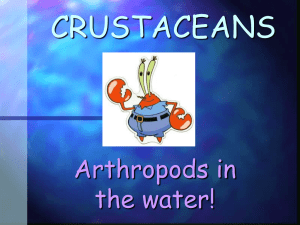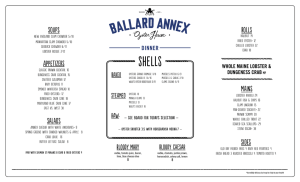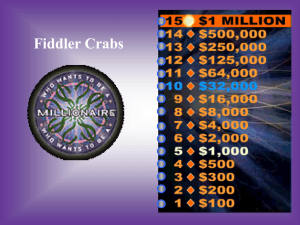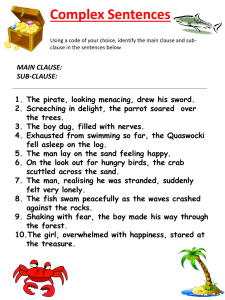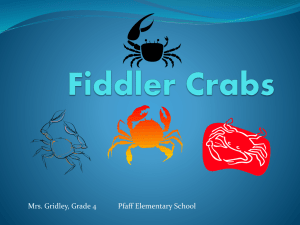Marine Arthropods LCS ppt
advertisement
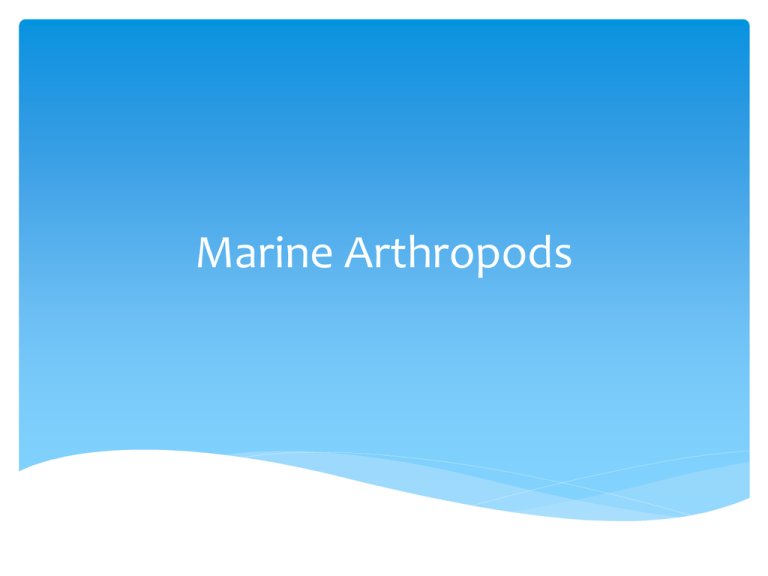
Marine Arthropods Invertebrates Arthropods Characteristics of Phylum: – – – – – – – – – About 1 million species known, mostly marine Most marine species are in a group of arthropods called crustaceans About 75% of all animals on earth are arthropods Chitin exoskeleton- hard, but light and moderately flexible Since the skeleton is external, an arthropod must shed the shell to be able to grow – this process is called molting. There is a soft new shell underneath. Jointed appendages Many divided into sections called head, thorax and abdomen Specialized segmentation- segments combined for specific functions Specialized eye & sensory organs- wide angle of vision Invertebrates Arthropods Characteristics of phylum: – Specialized respiratory structures, gills, used for gas exchange – Some are filter feeders, some scavengers, others carnivores Invertebrates Types of Marine Arthropods: Crustaceans 68,000 species 2 pairs antennae Gills for respiration Head and thorax fused into a single unit called a cephalothorax; entire external body is called the carapace Large array of appendages specialized for different functions; ex: pinchers on crabs, swimmerettes on the underside of shrimp hold developing eggs, etc. Types of crustaceans – copepods, barnacles, amphipods, isopods, crabs, shrimp, lobsters, etc. Characteristics of Crustacea External a. Appendages 2 prs of antennae: 1st homologous to antennae of insects & myriapods, 2nd homologous to chelicerae 3rd pair of head appendages are mandibles Biramous - terminal segment with endopod and exopod b. Tagmata Head and trunk (often divided into thorax and abdomen) A carapace may cover dorsal and lateral surfaces c. Exoskeleton chitin may be calcified in larger species Characteristics of Crustacea Feeding and Digestion a. Nearly all are suspension filter-feeders b. Larger species predator/scavengers c. Appendages specialized for cutting, tearing, collecting d. Foregut enlarged into cardiac and pyloric stomach e. Midgut bears two digestive glands (hepatopancreas) comprised of highly branched, blind canals secrete enzymes absorb nutrients store glycogen and fat Gas Exchange, Circulation, and Excretion a. Respiration All Crustaceans have gills May be within thoracic cavity or on appendages b. Circulatory System Heart --> dorsal vessel --> sinuses --> gills -->pericardial sinus --> ostia in heart Respiratory proteins (hemocyanin) in blood of larger species c. Excretion Excretory organs near antennae (antennal glands) or maxillae (maxillary glands) Nervous and Sensory Structures a. CNS is typical for arthropods: dorsal brain, paired ventral nerve cord, ganglia b. Eyes of two types median simple eye (naupliar - from nauplius larvae) compound eyes - ommatidia (25 to 14,000) c. Prioprioceptors and statocysts in soft tissues between segments single pair at base of 1st antennae d. Sensory hairs for mechano- and chemoreception Phylum Arthropoda Class Crustacea Subclass Malacostraca Order Decapoda Order Amphipoda Order Isopoda Subclass Branchiopoda Subclass Ostracoda Subclass Copepoda Subclass Cirripedia Subclass Malacostraca "Soft Shell" Over half (>22,000 spp.) of Crustacea Typically 14 segments: 8 thorax, 6 abdomen First 1-3 thoracic are forward - maxillipeds Abdominal appendages called pleopods 1st pair often used in mating 6th pair is turned backward for swimming (uropods) Guess which crustcean we’re talking about first???? http://www.youtube.com/watch?v=4rT5fYMfEUc That’s right! SHRIMP! Subclass Malacostraca: Order Decapoda ("Ten Legs") 10,000 species - crabs, shrimp, lobster, crayfish Commercially and ecologically important Mostly marine, crayfish common freshwater, some intertidal crabs are "semi-terrestrial" 3 prs maxillipeds, 5 prs legs (1st pr often chelate) Gills in branchial chamber enclosed by carapace Carry eggs on pleopods (swimmerets) beneath body photo Shrimp Brine shrimp Who knows an interesting fact about these? Ever heard of “Sea Monkeys”? SEA MONKEYS!!!! No, really……. Sea Monkey Video http://www.youtube.com/watch?v=Vc85AjH3zWA How do they do that????? http://www.seamonkeysrule.info/amazingfacts.htm Pistol Shrimp 500 species All pistol shrimp have one (Or sometimes two) oversized claw that create a cavitation bubble as it snaps shut. This bubble, very briefly reaches temperatures approaching that of the sun, about 4700 degrees Celsius. A loud "popping" noise is created as well. Despite being less than an inch long, the creatures can emit an astonishing 218 decibels - louder than a gunshot. BBC Pistol Shrimp http://www.youtube.com/watch?v=XC6I8iPiHT8 Goby and shrimp http://www.youtube.com/watch?v=FEslHsv-HF4 Peppermint shrimp Shrimp life cycle Shrimp eggs Shrimp eggs are tiny, almost invisible particles released deep in Gulf waters to float in the water column, providing food for zooplankton and incidental nutrition primarily for filter feeders ranging from rays and sharks to mollusks. Nauplius Larva and Protozoea Larva Larvae develop from floating fertilized eggs, growing and molting through many of each of these stages over a twoor three-week period. They cannot swim or control their movements. They feed on nanoplankton, zooplankton and phytoplankton (green algae, copepods and diatoms) as well as suspended detritus, while small fishes and filter feeders consume some of them. Mysis Larva Maturing larvae in the mysis stage are carried towards shore by flood tides and wind-driven currents, continuing to feed on zooplankton and phytoplankton. A shrimp larva at this life stage is large enough in size for some juvenile fish to see and hunt. Its niche is more noticeable and it is more aware of its environment. Mysis larvae seem to respond to light by moving away from it — that is down in the water column to avoid predators – although they do not yet have swimming appendages. Postlarva Currents and incoming tides carry the maturing crustacean into brackish (mixture of salt and fresh water) estuarine waters. Over a 4-6 week period, the individuals begin to look like shrimp and to forage or graze like shrimp, clinging to the bottom most of the time. They develop swimming and walking legs. Juveniles Small juveniles prefer shallow salty water along the edges of marshes, where plants provide both cover and detritus, and where microorganisms thrive in the soft bottom. Small juvenile shrimp are food for juvenile fishes also living in the estuary such as southern flounder, spotted seatrout, red drum, inshore lizard fish, Atlantic croaker and pinfish. Adult Move back to the sea. Out in the Gulf once more, the adult shrimp continues to grow in size on the sea’s bottom as an opportunistic omnivore, and its niche at this stage is primarily as food for many. It lives in deep water, 60-500 feet below the sea’s surface. when there is a sharp increase in the water column’s temperature the females will spawn, producing thousands of eggs to begin the cycle again. Shrimp anatomy Shrimp or Crayfish observation Uropod- The sixth and last pair of abdominal appendages of lobsters and related crustaceans, forming part of the tail fan. Telson- the terminal segment of the body of an arthropod Rostrum- the often spinelike anterior median prolongation of the carapace of a crustacean Pleopod- an abdominal limb of a crustacean Maxillipeds- any of the crustacean appendages that comprise the first pair or first three pairs situated next behind the maxillae Carapace- a bony or chitinous case or shield covering the back or part of the back of an animal Antennae- Crayfish Crayfish life cycle How are lobster and crayfish different http://animals.howstuffworks.com/marinelife/crayfish-info.htm Decapod video 3 min http://www.youtube.com/watch?v=0_HGZESgbjs Lobster B 52’s Rock Lobster!!!!! http://www.youtube.com/watch?v=Oh5J33KAaqw Lobsters are carnivores (meat-eaters). Most lobsters are nocturnal (most active at night). They are predators that eat crabs, clams, worms, snails, mussels, flounder, and other lobsters Many animals eat lobsters, including fish (especially cod), octopi, other lobsters, and people. Lobsters continue to grow throughout their lives. The biggest lobster caught weighed over 44 pounds (20 kg). Lobsters may live to be 100 years old Largest Lobster The largest American lobster was caught off of Nova Scotia, and weighed 44 pounds, 6 ounces and was 3 feet, 6 inches long. 1977 Lobster facts Lobsters and other crustaceans inhabit all the world’s major oceans. Although lobsters can be found worldwide, different types of lobster choose different areas in which to live. Many lobsters live in shallow water in the coastal areas around islands. One group of lobsters, called deep-sea lobsters, lives in the cold, deep sea. On its antennae, legs, carapace, and tail, a lobster has tiny, hairlike receptors that can detect specific chemical molecules in the environment, which help the lobster to identify and locate food. The lobster crawls over the bottom of the sea, eating dead and living fish, starfish, clams, and other animals and seaweed. It grinds its food with six pairs of jaws. The food is then further ground and mixed with digestive juices in the stomach, which contains toothlike grinding organs. Much of the information a lobster gets about its surroundings is gathered by millions of tiny hairlike sensors on its antennae, mouthparts, legs, and shell. Some of these sensors “sniff” chemicals that help lobsters locate and taste food. Others warn lobsters of predators or alert them to potential mates.A lobster also has special organs located at the base of its antennules, as the shorter pair of antennae are called. These organs are pits that are lined with tiny bristles. As a lobster moves, particles that are floating within the pits bend the tiny bristles in different directions. Signals that are sent from these bristles through the lobster’s nervous system help the lobster determine its position in its surroundings and keep its balance. molting The lobster molts, or sheds its shell, frequently while young, less frequently as it grows. After molting it is helpless against predators and must hide until the new shell hardens. If it loses a claw or a leg, the lobster grows a new one. To molt, the lobster shrinks the muscles and other tissues in its limbs by releasing fluid out of the tissues. This lets the lobster withdraw its appendages from the surrounding shell. Once the shell cracks, the lobster is able to withdraw its entire body from its old shell. After it is out of its shell, the lobster takes in water to swell its body to a larger size. The new soft shell can withstand the pressure from the lobster’s swollen body without cracking. It takes several weeks for the new shell to harden around the swollen lobster. Once the new shell is hard, the lobster pushes the excess water out from its body. It now has a new, roomier shell to grow into. A typical American lobster is 12 inches (30 cm) long and weighs about 2 pounds (0.9 kg). Some grow to more than 3 feet (90 cm) long and weigh more than 40 pounds (18 kg). Spiny lobsters are about the same size as American lobsters. Lobsters can live as long as 100 years Types of lobster There are two kinds of lobsters, and these are commonly referred to as "clawed" lobsters and "spiny" lobsters, or rock lobsters. Clawed lobsters include the American lobster, a well-known marine species. Clawed lobsters are generally found in cold waters. Spiny lobsters do not have claws, but instead have long, strong antennae. These lobsters are generally found in warm water. American Lobster “clawed” Spiny Lobster- NO CLAWS American lobsters thrive in the cool waters of the North Atlantic Ocean. These lobsters inhabit sandy, muddy, and rocky areas of the ocean floor from Virginia in the United States to Newfoundland and Labrador in Canada. Spiny and slipper lobsters are found in warm waters throughout the world. Spiny lobsters live in coral reefs, on rock ledges, and in crevices. Slipper lobsters are usually found in muddy or sandy places. Lobster reproduction The female American lobster carries fertilized eggs on the underside of its abdomen until the eggs are ready to hatch. The eggs are covered by a sticky cement that hardens and holds them in place. Eggs of the spiny lobster are released to float in the ocean shortly after they have been fertilized. The newly hatched lobsters do not resemble the adults for several weeks, during which time they go through various stages of development. Lobsters mature at four or five years of age. Females, depending on their size, produce 3,000 to 100,000 eggs at one time. Lobster life cycle Male or female??? How do you tell the difference between a male and female lobster? Look under its tail. On the underside of its tail, a lobster has swimmerets, which are used to help the lobster swim and in mating. The male has a modified pair of swimmerets http://www.youtube.com/watch?v=eJY-IDyrFXs Male or female???? Lobster reproduction video 1:09 http://www.youtube.com/watch?v=Y3nkJMaWaB4 http://www.youtube.com/watch?v=h6nhOChpMck What is a lobster “MARCH” To protect themselves from predators, fish swim in schools. Birds fly in flocks. And lobsters “march.” Predators often have a difficult time capturing prey traveling in such groups. During a lobster march, dozens of spiny lobsters walk together in long rows, like ants or soldiers. The lobsters walk so close together that the antennae of one lobster may touch the tail of the lobster in front of it. In the Caribbean Sea, lobster marches are often observed after a storm. At these times, the lobsters are usually marching out to deeper water. Some people believe that storms trigger lobster marches. Scientists, however, are not sure why spiny lobsters march to other locations. Are they moving to deeper waters to protect themselves from winter storms? Are they looking for new breeding grounds? New feeding grounds? The answer remains a mystery. Lobster march video Lobster Video Man vs Wild “Lobster Brains” 2:16 http://www.youtube.com/watch?v=fIIr_Bh4yNs Loggerhead vs Lobster http://www.youtube.com/watch?v=IIjk84-hxE0 crab facts Abdomen small tucked under compact and typically broad cephalothorax Walk sideways Scavengers, predators, some have specialized diets of seaweeds, organic matter in mud, or coral mucus Male or female? V-shaped abdomen is male U-shaped is female Male or female?? Reproduction When male and female crabs reproduce, they assume the doubler position, which is when the male carries the female. Mating lasts about five-and-a-half hours, but the crabs may stay in this position for up to three days afterward. The female stores the male's sperm on the underside of her abdomen, where it will be used for two more spawnings that occur within her threeyear lifespan. The females migrate to slightly saltier waters after mating and attach between 100,000 to two million eggs to the sperm stored under the abdomen. The incubation period lasts about two weeks, until the crab larvae hatch and are released into the ocean to fend for themselves. For the next 40 days, the crab larvae continue to grow until they reach the adult crab stage. Anatomy Crab examination Dungeness Crab habitat Live along rocky shores or sandy beaches Marine crabs can live on land for 4-5 days by using the water they store in their gills OR on the ocean floor Depends on whether they are crustcean crabs or in another subclass as we will discuss later Marine crabs and terrestrial crabs are NOT the same Snow crab Snow Crab named for their sweet, delicate, snow-white meat Commercial size males are usually older than 8 years and weigh between 1 and 2 pounds. King crab King crab most common are Red, Blue, and Golden King crabs which are generally found in Alaskan waters Fishing for king crabs is largely carried out in Alaska The king crab usually feeds off of starfish and smaller crabs, but if they are not available, the king crab will eat dead animals that may fall into the water “crabbin” http://www.youtube.com/watch?v=Yct7za_P4lA http://www.youtube.com/watch?v=roc9VSnoMLM http://www.youtube.com/watch?v=deXE2bgzeo4 “crabbin”…. The most lucrative Alaskan crab fisheries occur in the fall and winter; the seasons are often short, lasting less than four weeks. In the Bering Sea specifically, the two most active months are October and January. Each season, approximately 250 crab fishing boats converge on Dutch Harbor, Alaska, in search of Alaskan king crab. Crab vessels cost several million dollars to build, and tens of thousands of dollars to operate annually. The boats range in size from 40 to 200 feet; each crew typically consists of one captain and three to nine deckhands. “crabbin”…… Because the sonar used on most fishing boats is downwardpointing, it doesn't detect crabs that are right against or buried in the ocean floor. Furthermore, since it is impossible to predict where adult male crabs will be (unless it's spring, which is mating season), captains must rely on intuition to find the best crabbing location. To catch the crabs, fishermen use 700-pound steel traps ("pots") baited with ground herring, squid, sardines and cod, which are dropped 400 feet below the ocean's surface. On average, the pots measure 7 feet by 7 feet by 3 feet, and soak anywhere from five to 24 hours before being hauled back on deck. Crab pots- how they work http://www.youtube.com/watch?v=UXjmNtldnAI “crabbin”…….. In 1980, at the peak of the king crab industry, Alaskan fisheries produced up to 200,000,000 lb (91,000,000 kg) of crab. However, by 1983, the total size of the catch had dropped by up to 90% in some places At $4.50 per pound (up from $3.90 last year), fishermen can make between $27 and $45 for each red king crab they catch. At about $1.70 per pound (up from $1.50 last year), an average opilio crab can fetch $1.70 to $5.10. “crabbin”……. Fishermen are allowed to harvest only adult male crab. All females and juveniles must be thrown back If a crab dies in the boat’s holding tank, it emits toxins that can poison the other crabs; one dead crab has the potential to wipe out the entire catch Blue crab Blue crab The blue crab is so named because of its sapphiretinted claws Prized by humans for their sweet, tender meat Weight: 1 to 2 lbs Blue crabs are found in brackish coastal lagoons and estuaries from Nova Scotia, through the Gulf of Mexico Did you know? Female blue crabs mate only once in their lives. Emerald crab Fiddler Crab Fiddler crab Fiddler crabs are found along sea beaches and brackish inter-tidal mud flats, lagoons and swamps they joust with each other with their huge claw. change color be altering the size of cells that contain pigments, becoming darker in the day and pale again at night. If they have lost legs or claws during their present growth cycle a new one will be present when they molt. If the large claw is lost, males will develop one on the opposite side after their next molt. Crab Lab What about hermit crabs??? Hermit crabs Hermit crabs are not really classed as crabs due to the fact that they do not own their own shell 600 species can live as long as 15 years Coconut crab (interesting but not marine) Largest terrestrial arthropod in the world Known for its ability to crack coconuts with its strong pincers in order to eat the contents Also called the robber crab FOUR pairs of legs instead of FIVE Mostly in Australia and Madagascar Hermit crab Other types of Arthropods Order Amphipoda Order Isopoda Subclass Copepoda Class Merostomata- Horseshoe Crabs Class Pycnogonida- sea spiders Subclass Malacostraca: Order Amphipoda ("Double Legs") 6000 species Mostly marine or freshwater, damp terrestrial Laterally compressed body, mostly small (< 2 cm) Abdomen is not clearly demarcated from thorax Large thoracic coxae on legs Appear "hunchback" photo Beach Hopper Common in shore debris. Strong jumpers that spring about by briskly stretching their curved bodies Whale lice Burrows in skin of whales Subclass Malacostraca: Order Isopoda ("Same Legs") 4000 species Mostly marine benthic, some freshwater Wood lice are largest group of terrestrial crustaceans Most are < 2 cm; some quite large (> 40 cm) Dorso-ventrally flattened Head is "shield-shaped" Abdomen same width as thorax Subclass Copepoda "Oar-Footed" Largest Class of microscopic crustacea > 8,500 species, marine and freshwater May be very important in aquatic food webs Feed mostly on bacteria and phytoplankton Bulbous head, tapered posteriorly Trunk segmentation well-developed Paddle-like appendages A pair of caudal cerci are distinctive Compound eyes absent, median naupliar eye photo Invertebrates Types of Marine Arthropods: Horseshoe crabs (only surviving members)- class Merostomata Not true crabs 5 pairs of legs, first pair modified in males for reproduction Females larger than males Mating pairs come onto beaches each spring to breed and lay their eggs in wet sand Among the oldest creatures on earth – they have remained virtually unchanged for millions of years They live and borrow in soft sediments, normally near shore where they feed on other invertebrates and scavenge. Atlantic and gulf of North America and Southeast Asia Horseshoe Crab Video http://www.youtube.com/watch?v=y6RvgwrzK9c Invertebrates Types of Marine Arthropods Sea Spiders: Superficially resemble spiders Four of more pairs of jointed legs Not insects or true spiders Possess a mouth and proboscis for feeding Mainly feed on sea anemones and hydrozoans (they are voracious predators!) More common in cold waters, but can be found worldwide Arthropod Reproduction – Male transfers sperm directly to female to ensure reproductive success – In some species, female will house eggs for a time until they are further developed – Females can store sperm for fertilization at a later time – Many arthropods have complex behaviors including mating rituals

